Sherrie Wang
Department of Earth System Science and Center on Food Security and the Environment, Stanford University, Institute for Computational and Mathematical Engineering, Stanford University, Goldman School of Public Policy, University of California, Berkeley
Invariant Features for Global Crop Type Classification
Sep 04, 2025



Abstract:Accurately obtaining crop type and its spatial distribution at a global scale is critical for food security, agricultural policy-making, and sustainable development. Remote sensing offers an efficient solution for large-scale crop classification, but the limited availability of reliable ground samples in many regions constrains applicability across geographic areas. To address performance declines under geospatial shifts, this study identifies remote sensing features that are invariant to geographic variation and proposes strategies to enhance cross-regional generalization. We construct CropGlobe, a global crop type dataset with 300,000 pixel-level samples from eight countries across five continents, covering six major food and industrial crops (corn, soybeans, rice, wheat, sugarcane, cotton). With broad geographic coverage, CropGlobe enables a systematic evaluation under cross-country, cross-continent, and cross-hemisphere transfer. We compare the transferability of temporal multi-spectral features (Sentinel-2-based 1D/2D median features and harmonic coefficients) and hyperspectral features (from EMIT). To improve generalization under spectral and phenological shifts, we design CropNet, a lightweight and robust CNN tailored for pixel-level crop classification, coupled with temporal data augmentation (time shift, time scale, and magnitude warping) that simulates realistic cross-regional phenology. Experiments show that 2D median temporal features from Sentinel-2 consistently exhibit the strongest invariance across all transfer scenarios, and augmentation further improves robustness, particularly when training data diversity is limited. Overall, the work identifies more invariant feature representations that enhance geographic transferability and suggests a promising path toward scalable, low-cost crop type applications across globally diverse regions.
Prediction-Powered Inference with Imputed Covariates and Nonuniform Sampling
Jan 30, 2025



Abstract:Machine learning models are increasingly used to produce predictions that serve as input data in subsequent statistical analyses. For example, computer vision predictions of economic and environmental indicators based on satellite imagery are used in downstream regressions; similarly, language models are widely used to approximate human ratings and opinions in social science research. However, failure to properly account for errors in the machine learning predictions renders standard statistical procedures invalid. Prior work uses what we call the Predict-Then-Debias estimator to give valid confidence intervals when machine learning algorithms impute missing variables, assuming a small complete sample from the population of interest. We expand the scope by introducing bootstrap confidence intervals that apply when the complete data is a nonuniform (i.e., weighted, stratified, or clustered) sample and to settings where an arbitrary subset of features is imputed. Importantly, the method can be applied to many settings without requiring additional calculations. We prove that these confidence intervals are valid under no assumptions on the quality of the machine learning model and are no wider than the intervals obtained by methods that do not use machine learning predictions.
Multi-modal graph neural networks for localized off-grid weather forecasting
Oct 16, 2024Abstract:Urgent applications like wildfire management and renewable energy generation require precise, localized weather forecasts near the Earth's surface. However, weather forecast products from machine learning or numerical weather models are currently generated on a global regular grid, on which a naive interpolation cannot accurately reflect fine-grained weather patterns close to the ground. In this work, we train a heterogeneous graph neural network (GNN) end-to-end to downscale gridded forecasts to off-grid locations of interest. This multi-modal GNN takes advantage of local historical weather observations (e.g., wind, temperature) to correct the gridded weather forecast at different lead times towards locally accurate forecasts. Each data modality is modeled as a different type of node in the graph. Using message passing, the node at the prediction location aggregates information from its heterogeneous neighbor nodes. Experiments using weather stations across the Northeastern United States show that our model outperforms a range of data-driven and non-data-driven off-grid forecasting methods. Our approach demonstrates how the gap between global large-scale weather models and locally accurate predictions can be bridged to inform localized decision-making.
Quantifying uncertainty in area and regression coefficient estimation from remote sensing maps
Jul 18, 2024



Abstract:Remote sensing map products are used to obtain estimates of environmental quantities, such as deforested area or the effect of conservation zones on deforestation. However, the quality of map products varies, and - because maps are outputs of complex machine learning algorithms that take in a variety of remotely sensed variables as inputs - errors are difficult to characterize. Without capturing the biases that may be present, naive calculations of population-level estimates from such maps are statistically invalid. In this paper, we compare several uncertainty quantification methods - stratification, Olofsson area estimation method, and prediction-powered inference - that combine a small amount of randomly sampled ground truth data with large-scale remote sensing map products to generate statistically valid estimates. Applying these methods across four remote sensing use cases in area and regression coefficient estimation, we find that they result in estimates that are more reliable than naively using the map product as if it were 100% accurate and have lower uncertainty than using only the ground truth and ignoring the map product. Prediction-powered inference uses ground truth data to correct for bias in the map product estimate and (unlike stratification) does not require us to choose a map product before sampling. This is the first work to (1) apply prediction-powered inference to remote sensing estimation tasks, and (2) perform uncertainty quantification on remote sensing regression coefficients without assumptions on the structure of map product errors. To improve the utility of machine learning-generated remote sensing maps for downstream applications, we recommend that map producers provide a holdout ground truth dataset to be used for calibration in uncertainty quantification alongside their maps.
Good at captioning, bad at counting: Benchmarking GPT-4V on Earth observation data
Jan 31, 2024Abstract:Large Vision-Language Models (VLMs) have demonstrated impressive performance on complex tasks involving visual input with natural language instructions. However, it remains unclear to what extent capabilities on natural images transfer to Earth observation (EO) data, which are predominantly satellite and aerial images less common in VLM training data. In this work, we propose a comprehensive benchmark to gauge the progress of VLMs toward being useful tools for EO data by assessing their abilities on scene understanding, localization and counting, and change detection tasks. Motivated by real-world applications, our benchmark includes scenarios like urban monitoring, disaster relief, land use, and conservation. We discover that, although state-of-the-art VLMs like GPT-4V possess extensive world knowledge that leads to strong performance on open-ended tasks like location understanding and image captioning, their poor spatial reasoning limits usefulness on object localization and counting tasks. Our benchmark will be made publicly available at https://vleo.danielz.ch/ and on Hugging Face at https://huggingface.co/collections/mit-ei/vleo-benchmark-datasets-65b789b0466555489cce0d70 for easy model evaluation.
Taking it further: leveraging pseudo labels for field delineation across label-scarce smallholder regions
Dec 12, 2023



Abstract:Transfer learning allows for resource-efficient geographic transfer of pre-trained field delineation models. However, the scarcity of labeled data for complex and dynamic smallholder landscapes, particularly in Sub-Saharan Africa, remains a major bottleneck for large-area field delineation. This study explores opportunities of using sparse field delineation pseudo labels for fine-tuning models across geographies and sensor characteristics. We build on a FracTAL ResUNet trained for crop field delineation in India (median field size of 0.24 ha) and use this pre-trained model to generate pseudo labels in Mozambique (median field size of 0.06 ha). We designed multiple pseudo label selection strategies and compared the quantities, area properties, seasonal distribution, and spatial agreement of the pseudo labels against human-annotated training labels (n = 1,512). We then used the human-annotated labels and the pseudo labels for model fine-tuning and compared predictions against human field annotations (n = 2,199). Our results indicate i) a good baseline performance of the pre-trained model in both field delineation and field size estimation, and ii) the added value of regional fine-tuning with performance improvements in nearly all experiments. Moreover, we found iii) substantial performance increases when using only pseudo labels (up to 77% of the IoU increases and 68% of the RMSE decreases obtained by human labels), and iv) additional performance increases when complementing human annotations with pseudo labels. Pseudo labels can be efficiently generated at scale and thus facilitate domain adaptation in label-scarce settings. The workflow presented here is a stepping stone for overcoming the persisting data gaps in heterogeneous smallholder agriculture of Sub-Saharan Africa, where labels are commonly scarce.
Combining deep learning and street view imagery to map smallholder crop types
Sep 12, 2023


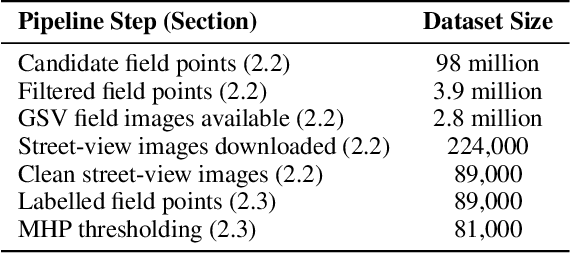
Abstract:Accurate crop type maps are an essential source of information for monitoring yield progress at scale, projecting global crop production, and planning effective policies. To date, however, crop type maps remain challenging to create in low and middle-income countries due to a lack of ground truth labels for training machine learning models. Field surveys are the gold standard in terms of accuracy but require an often-prohibitively large amount of time, money, and statistical capacity. In recent years, street-level imagery, such as Google Street View, KartaView, and Mapillary, has become available around the world. Such imagery contains rich information about crop types grown at particular locations and times. In this work, we develop an automated system to generate crop type ground references using deep learning and Google Street View imagery. The method efficiently curates a set of street view images containing crop fields, trains a model to predict crop type by utilizing weakly-labelled images from disparate out-of-domain sources, and combines predicted labels with remote sensing time series to create a wall-to-wall crop type map. We show that, in Thailand, the resulting country-wide map of rice, cassava, maize, and sugarcane achieves an accuracy of 93%. As the availability of roadside imagery expands, our pipeline provides a way to map crop types at scale around the globe, especially in underserved smallholder regions.
Annual field-scale maps of tall and short crops at the global scale using GEDI and Sentinel-2
Dec 19, 2022Abstract:Crop type maps are critical for tracking agricultural land use and estimating crop production. Remote sensing has proven an efficient and reliable tool for creating these maps in regions with abundant ground labels for model training, yet these labels remain difficult to obtain in many regions and years. NASA's Global Ecosystem Dynamics Investigation (GEDI) spaceborne lidar instrument, originally designed for forest monitoring, has shown promise for distinguishing tall and short crops. In the current study, we leverage GEDI to develop wall-to-wall maps of short vs tall crops on a global scale at 10 m resolution for 2019-2021. Specifically, we show that (1) GEDI returns can reliably be classified into tall and short crops after removing shots with extreme view angles or topographic slope, (2) the frequency of tall crops over time can be used to identify months when tall crops are at their peak height, and (3) GEDI shots in these months can then be used to train random forest models that use Sentinel-2 time series to accurately predict short vs. tall crops. Independent reference data from around the world are then used to evaluate these GEDI-S2 maps. We find that GEDI-S2 performed nearly as well as models trained on thousands of local reference training points, with accuracies of at least 87% and often above 90% throughout the Americas, Europe, and East Asia. Systematic underestimation of tall crop area was observed in regions where crops frequently exhibit low biomass, namely Africa and South Asia, and further work is needed in these systems. Although the GEDI-S2 approach only differentiates tall from short crops, in many landscapes this distinction goes a long way toward mapping the main individual crop types. The combination of GEDI and Sentinel-2 thus presents a very promising path towards global crop mapping with minimal reliance on ground data.
Unlocking large-scale crop field delineation in smallholder farming systems with transfer learning and weak supervision
Jan 13, 2022



Abstract:Crop field boundaries aid in mapping crop types, predicting yields, and delivering field-scale analytics to farmers. Recent years have seen the successful application of deep learning to delineating field boundaries in industrial agricultural systems, but field boundary datasets remain missing in smallholder systems due to (1) small fields that require high resolution satellite imagery to delineate and (2) a lack of ground labels for model training and validation. In this work, we combine transfer learning and weak supervision to overcome these challenges, and we demonstrate the methods' success in India where we efficiently generated 10,000 new field labels. Our best model uses 1.5m resolution Airbus SPOT imagery as input, pre-trains a state-of-the-art neural network on France field boundaries, and fine-tunes on India labels to achieve a median Intersection over Union (IoU) of 0.86 in India. If using 4.8m resolution PlanetScope imagery instead, the best model achieves a median IoU of 0.72. Experiments also show that pre-training in France reduces the number of India field labels needed to achieve a given performance level by as much as $20\times$ when datasets are small. These findings suggest our method is a scalable approach for delineating crop fields in regions of the world that currently lack field boundary datasets. We publicly release the 10,000 labels and delineation model to facilitate the creation of field boundary maps and new methods by the community.
SustainBench: Benchmarks for Monitoring the Sustainable Development Goals with Machine Learning
Nov 08, 2021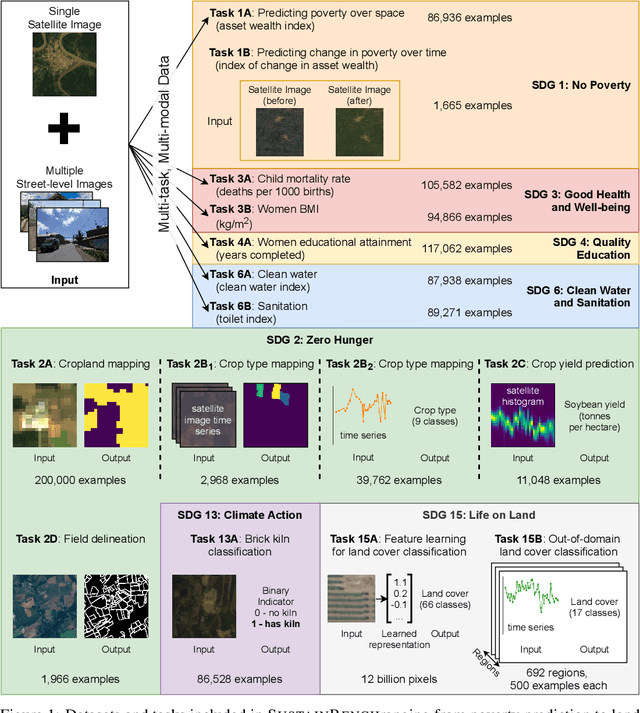
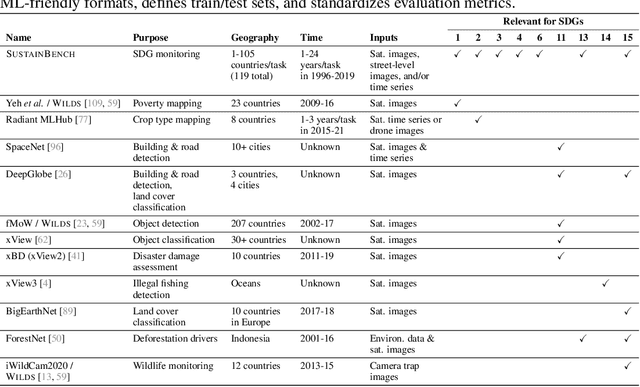
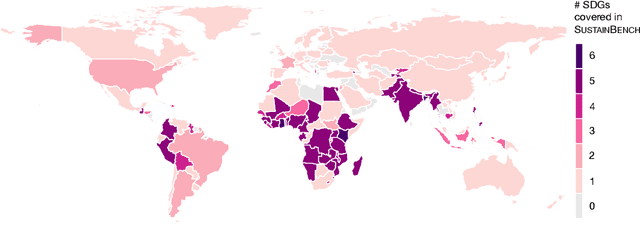
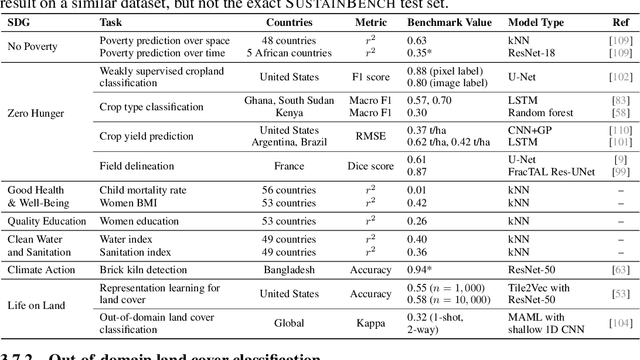
Abstract:Progress toward the United Nations Sustainable Development Goals (SDGs) has been hindered by a lack of data on key environmental and socioeconomic indicators, which historically have come from ground surveys with sparse temporal and spatial coverage. Recent advances in machine learning have made it possible to utilize abundant, frequently-updated, and globally available data, such as from satellites or social media, to provide insights into progress toward SDGs. Despite promising early results, approaches to using such data for SDG measurement thus far have largely evaluated on different datasets or used inconsistent evaluation metrics, making it hard to understand whether performance is improving and where additional research would be most fruitful. Furthermore, processing satellite and ground survey data requires domain knowledge that many in the machine learning community lack. In this paper, we introduce SustainBench, a collection of 15 benchmark tasks across 7 SDGs, including tasks related to economic development, agriculture, health, education, water and sanitation, climate action, and life on land. Datasets for 11 of the 15 tasks are released publicly for the first time. Our goals for SustainBench are to (1) lower the barriers to entry for the machine learning community to contribute to measuring and achieving the SDGs; (2) provide standard benchmarks for evaluating machine learning models on tasks across a variety of SDGs; and (3) encourage the development of novel machine learning methods where improved model performance facilitates progress towards the SDGs.
 Add to Chrome
Add to Chrome Add to Firefox
Add to Firefox Add to Edge
Add to Edge